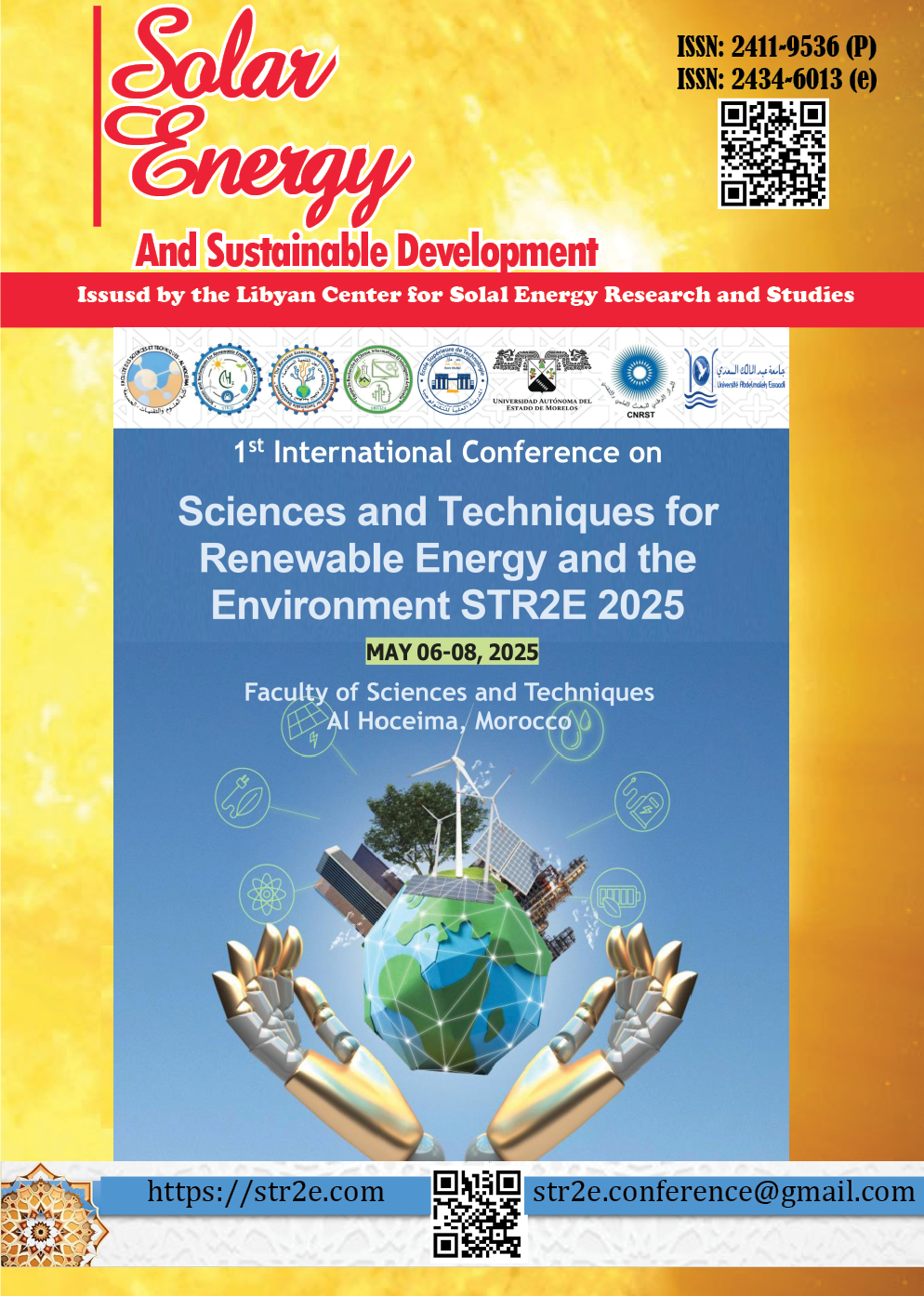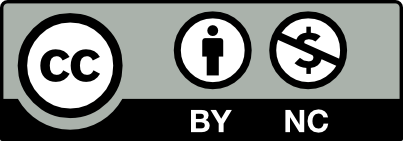Improving PEM Water Electrolysis Efficiency with ANN-Based Control to Handle Rapid Photovoltaic Power Fluctuations
DOI:
https://doi.org/10.51646/jsesd.v14iSTR2E.985Keywords:
Hydrogen production, Renewable energy, PEM electrolyzer, DC-DC Converter, Artificial Neural Network.Abstract
This research presents an innovative method for enhancing hydrogen production through proton exchange membrane (PEM) water electrolysis, powered by photovoltaic (PV) energy. The system is based on the Perturbation and Observation (P & O) method of Maximum Power Point Tracking (MPPT) with a boost converter to maximize energy capture, and a buck converter to stabilize DC voltage, ensuring compatibility with the proton exchange membrane electrolyzer. An artificial neural network (ANN)-based controller manages the buck converter, effectively minimizing the effects of solar irradiation fluctuations on electrolyzer performance. By using the adaptive learning capabilities of the ANN, the proposed approach increases the efficiency of hydrogen production under varying solar energy levels. Simulation results indicate that the ANN controller outperforms the conventional PI controller, reducing the mean absolute percentage error (MAPE) from 1.22 % to 0.95 %, decreasing overshoot from 12.84 % to 3.19 %, and achieving a faster settling time of 0.022 s compared to 0.023 s. This study advances renewable hydrogen production technologies, demonstrating that ANN-based control improves dynamic performance and contributes to the development of smarter, more resilient energy systems.
Downloads
Metrics
References
Q. Hassan, S. Algburi, A. Z. Sameen, H. M. Salman, and M. Jaszczur, “Green hydrogen: A pathway to a sustainable energy future,” Int J Hydrogen Energy, vol. 50, pp. 310–333, 2024, doi: https://doi.org/10.1016/j.ijhydene.2023.08.321. DOI: https://doi.org/10.1016/j.ijhydene.2023.08.321
B. Reda, A. A. Elzamar, S. AlFazzani, and S. M. Ezzat, “Green hydrogen as a source of renewable energy: a step towards sustainability, an overview,” Environ Dev Sustain, May 2024, doi: 10.1007/s10668-024-04892-z. DOI: https://doi.org/10.1007/s10668-024-04892-z
C. Laghlimi, A. Moutcine, Y. Ziat, H. Belkhanchi, A. Koufi, and S. Bouyassan, “Hydrogen, Chronology and Electrochemical Production,” JSESD, pp. 22–37, Dec. 2024, doi: https://doi.org/10.51646/jsesd.v14iSI_MSMS2E.405. DOI: https://doi.org/10.51646/jsesd.v14iSI_MSMS2E.405
D. Mazumdar, C. Sain, P. K. Biswas, P. Sanjeevikumar, and B. Khan, “Overview of solar photovoltaic MPPT methods: a state of the art on conventional and artificial intelligence control techniques,” International Transactions on Electrical Energy Systems, vol. 2024, no. 1, p. 8363342, 2024, Accessed: Apr. 03, 2025. [Online]. Available: https://doi.org/10.1155/2024/8363342 DOI: https://doi.org/10.1155/2024/8363342
Y. Astriani, W. Tushar, and M. Nadarajah, “Optimal planning of renewable energy park for green hydrogen production using detailed cost and efficiency curves of PEM electrolyzer,” Int J Hydrogen Energy, vol. 79, pp. 1331–1346, 2024, Accessed: Apr. 03, 2025. [Online]. Available: https://doi.org/10.1016/j.ijhydene.2024.07.107 DOI: https://doi.org/10.1016/j.ijhydene.2024.07.107
C. Yan, Y. Zou, Z. Wu, and A. Maleki, “Effect of various design configurations and operating conditions for optimization of a wind/solar/hydrogen/fuel cell hybrid microgrid system by a bio-inspired algorithm,” Int J Hydrogen Energy, vol. 60, pp. 378–391, 2024, Accessed: Apr. 03, 2025. [Online]. Available: https://doi.org/10.1016/j.ijhydene.2024.02.004 DOI: https://doi.org/10.1016/j.ijhydene.2024.02.004
F. S. Al-Ismail, “A critical review on DC microgrids voltage control and power management,” IEEE Access, 2024, doi: 10.1109/ACCESS.2024.3369609. DOI: https://doi.org/10.1109/ACCESS.2024.3369609
V. A. M. Lopez, H. Ziar, J. W. Haverkort, M. Zeman, and O. Isabella, “Dynamic operation of water electrolyzers: A review for applications in photovoltaic systems integration,” Renewable and Sustainable Energy Reviews, vol. 182, p. 113407, 2023, Accessed: Apr. 03, 2025. [Online]. Available: https://doi.org/10.1016/j.rser.2023.113407 DOI: https://doi.org/10.1016/j.rser.2023.113407
Z. Han, X. Yao, S. Yuan, H. Dong, S. Ma, and Y. Dong, “Research on control strategy of photovoltaic hydrogen generation system based on Fuzzy PI control,” Energy Reports, vol. 9, pp. 4187–4194, 2023, doi: https://doi.org/10.1016/j.egyr.2023.02.079. DOI: https://doi.org/10.1016/j.egyr.2023.02.079
M. Khalid, “Smart grids and renewable energy systems: Perspectives and grid integration challenges,” Energy Strategy Reviews, vol. 51, p. 101299, 2024, Accessed: Apr. 03, 2025. [Online]. Available: https://doi.org/10.1016/j.esr.2024.101299 DOI: https://doi.org/10.1016/j.esr.2024.101299
Z. Wei, P. W. Tien, J. Calautit, J. Darkwa, M. Worall, and R. Boukhanouf, “Investigation of a model predictive control (MPC) strategy for seasonal thermochemical energy storage systems in district heating networks,” Appl Energy, vol. 376, p. 124164, 2024, Accessed: Apr. 03, 2025. [Online]. Available: https://doi.org/10.1016/j.apenergy.2024.124164 DOI: https://doi.org/10.1016/j.apenergy.2024.124164
L. Wang et al., “An integrated deep learning model for intelligent recognition of long-distance natural gas pipeline features,” Reliab Eng Syst Saf, vol. 255, p. 110664, 2025, Accessed: Apr. 03, 2025. [Online]. Available: https://doi.org/10.1016/j.ress.2024.110664 DOI: https://doi.org/10.1016/j.ress.2024.110664
S. A. Kalogirou, “Applications of artificial neural networks in energy systems,” Energy Convers Manag, vol. 40, no. 10, pp. 1073–1087, 1999, doi: https://doi.org/10.1016/S0196-8904(99)00012-6. DOI: https://doi.org/10.1016/S0196-8904(99)00012-6
L. Nolting, T. Spiegel, M. Reich, M. Adam, and A. Praktiknjo, “Can energy system modeling benefit from artificial neural networks? Application of two-stage metamodels to reduce computation of security of supply assessments,” Comput Ind Eng, vol. 142, p. 106334, 2020, doi: https://doi.org/10.1016/j.cie.2020.106334. DOI: https://doi.org/10.1016/j.cie.2020.106334
M. Abdelkareem et al., “Progress of artificial neural networks applications in hydrogen production,” Chemical Engineering Research and Design, vol. 182, Mar. 2022, doi: 10.1016/j.cherd.2022.03.030. DOI: https://doi.org/10.1016/j.cherd.2022.03.030
L. Zou, Q. Shen, G. Yang, S. Li, and N. Huang, “Improved hydrogen production efficiency of a Photovoltaic-Electrolysis system with P&O Algorithm: A case study,” Chem Phys Lett, vol. 832, p. 140891, 2023, doi: https://doi.org/10.1016/j.cplett.2023.140891. DOI: https://doi.org/10.1016/j.cplett.2023.140891
A. Hassan, O. Abdel-Rahim, M. Bajaj, and I. Zaitsev, “Power electronics for green hydrogen generation with focus on methods, topologies, and comparative analysis,” Sci Rep, vol. 14, no. 1, p. 24767, 2024, Accessed: Apr. 03, 2025. [Online]. Available: https://doi.org/10.1038/s41598-024-76191-6 DOI: https://doi.org/10.1038/s41598-024-76191-6
M. A. Hossain, M. R. Islam, M. A. Hossain, and M. J. Hossain, “Control strategy review for hydrogen-renewable energy power system,” J Energy Storage, vol. 72, p. 108170, 2023, Accessed: Apr. 03, 2025. [Online]. Available: https://doi.org/10.1016/j.est.2023.108170 DOI: https://doi.org/10.1016/j.est.2023.108170
S. Adiche et al., “Advanced control strategy for AC microgrids: a hybrid ANN-based adaptive PI controller with droop control and virtual impedance technique,” Sci Rep, vol. 14, no. 1, p. 31057, 2024, Accessed: Apr. 03, 2025. [Online]. Available: https://doi.org/10.1038/s41598-024-82193-1 DOI: https://doi.org/10.1038/s41598-024-82193-1
M. E. Şahin, H. İ. Okumuş, and M. T. Aydemir, “Implementation of an electrolysis system with DC/DC synchronous buck converter,” Int J Hydrogen Energy, vol. 39, no. 13, pp. 6802–6812, 2014, doi: https://doi.org/10.1016/j.ijhydene.2014.02.084. DOI: https://doi.org/10.1016/j.ijhydene.2014.02.084
B. Yodwong, D. Guilbert, W. Kaewmanee, and M. Phattanasak, “Energy Efficiency Based Control Strategy of a Three-Level Interleaved DC-DC Buck Converter Supplying a Proton Exchange Membrane Electrolyzer,” Electronics (Basel), vol. 8, no. 9, 2019, doi: 10.3390/electronics8090933. DOI: https://doi.org/10.3390/electronics8090933
M. Albarghot and L. Rolland, “Comparison of experimental results with simulation of a PEM Electrolyzer powered by a horizontal wind turbine,” in 2017 International Conference of Electrical and Electronic Technologies for Automotive, 2017, pp. 1–6. doi: 10.23919/EETA.2017.7993232. DOI: https://doi.org/10.23919/EETA.2017.7993232
S. M. Muyeen, R. Takahashi, and J. Tamura, “Electrolyzer switching strategy for hydrogen generation from variable speed wind generator,” Electric Power Systems Research, vol. 81, no. 5, pp. 1171–1179, 2011, doi: https://doi.org/10.1016/j.epsr.2011.01.005. DOI: https://doi.org/10.1016/j.epsr.2011.01.005
F. Alonge, S. M. Collura, F. D’Ippolito, D. Guilbert, M. Luna, and G. Vitale, “Design of a robust controller for DC/DC converter–electrolyzer systems supplied by μWECSs subject to highly fluctuating wind speed,” Control Eng Pract, vol. 98, p. 104383, 2020, doi: https://doi.org/10.1016/j.conengprac.2020.104383. DOI: https://doi.org/10.1016/j.conengprac.2020.104383
R. K. Kumar and P. Samuel, “Designing a hydrogen generation system through PEM water electrolysis with the capability to adjust fast fluctuations in photovoltaic power,” Int J Hydrogen Energy, vol. 82, pp. 1–10, 2024, Accessed: Apr. 03, 2025. [Online]. Available: https://doi.org/10.1016/j.ijhydene.2024.07.376 DOI: https://doi.org/10.1016/j.ijhydene.2024.07.376
S. D. Al-Majidi, M. F. Abbod, and H. S. Al-Raweshidy, “A novel maximum power point tracking technique based on fuzzy logic for photovoltaic systems,” Int J Hydrogen Energy, vol. 43, no. 31, pp. 14158–14171, 2018, Accessed: Apr. 03, 2025. [Online]. Available: https://doi.org/10.1016/j.ijhydene.2018.06.002. DOI: https://doi.org/10.1016/j.ijhydene.2018.06.002
Downloads
Published
How to Cite
Issue
Section
License

This work is licensed under a Creative Commons Attribution-NonCommercial 4.0 International License.














